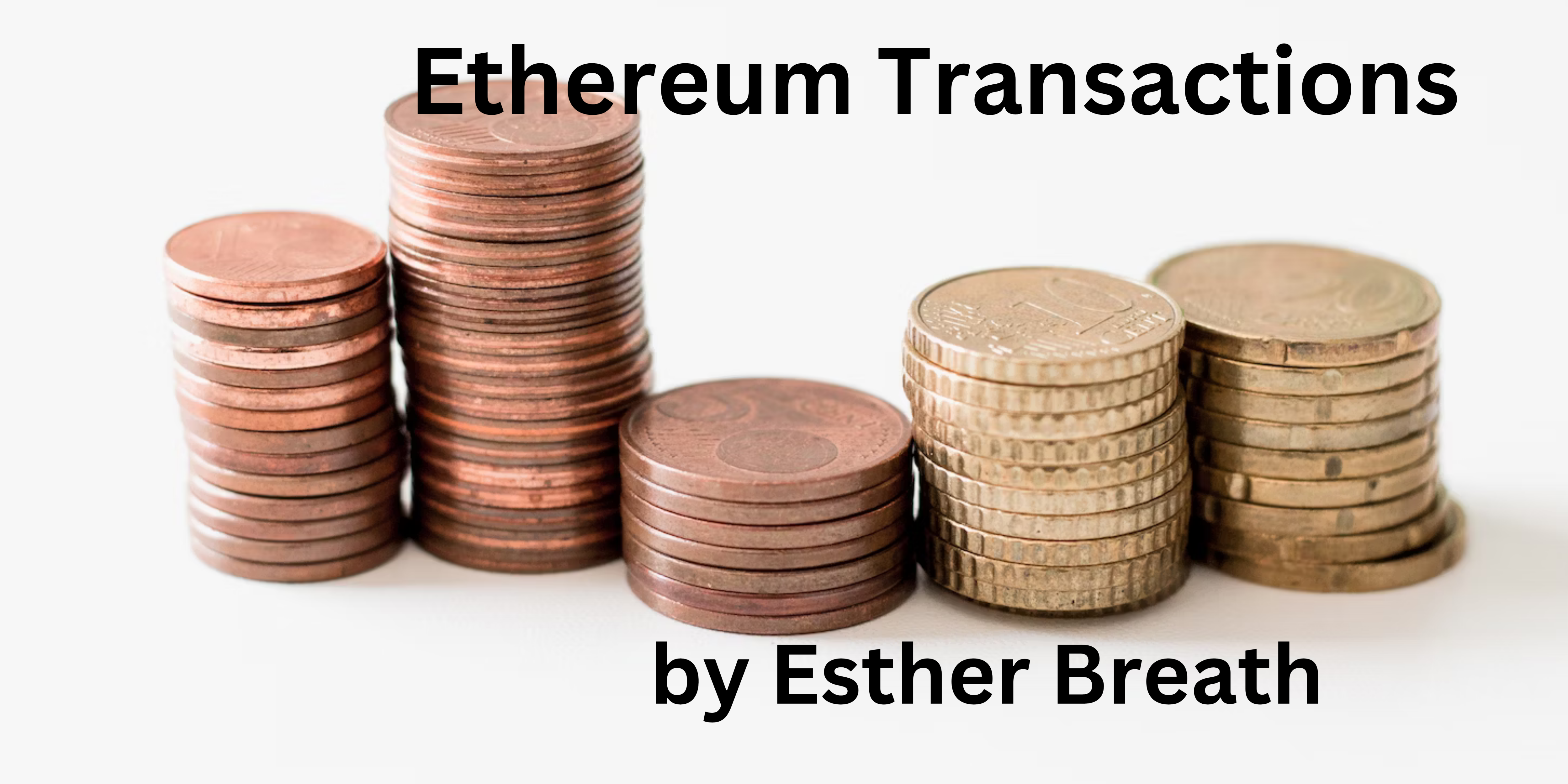Understanding an Ethereum Transaction
 Esther Breath
Esther Breath
An Ethereum transaction is a message sent to the Ethereum network from one account to another, that causes a change in the state of the blockchain. These transactions can include the transfer of ETH (the native currency of Ethereum) or other tokens from one address to another or interaction with a smart contract. The Ethereum transaction procedure is an important component. Anyone working in the cryptocurrency field has to understand how Ethereum transactions operate. We will go into the specifics of Ethereum transactions in this article, covering their life cycle, different types of transactions, variables influencing transaction speed, and tracking a transaction.
Types of Transaction
Before we go further to know how a transaction works, it is expedient to look at the types of transactions. There are three major types of Ethereum transactions that you can perform on the Ethereum blockchain.
Regular Transactions This is a transaction where an EOA (Externally Owned Account) also known as a wallet address sends ETH directly to another EOA.
Internal transactions: These transactions are generated by smart contracts. They include the transfer of ETH that is carried out between different accounts within the same smart contract. When viewing an address on Etherscan, this type of transaction will be shown under the Internal Txns tab.
Contract Interaction Transactions: These transactions involve executing a function in a smart contract. This concept is central to blockchain technology and plays a crucial role in enabling the functionality of decentralized applications (DApps), as well as the automation of various processes within the blockchain ecosystem.
The Life Cycle of a Transaction
Understanding the life cycle of an Ethereum transaction provides valuable insights into its journey from initiation to confirmation. Let's break it down into the following stages:
Initiation: A transaction is created and signed by the sender. The sender specifies the recipient's address, and the amount of Ether (ETH) or tokens to be sent. The transaction is then digitally signed with the sender's private key to ensure its authenticity and security
Broadcast: Once the transaction is created and signed, it is broadcast to the Ethereum network, meaning the transaction is shared with the network's nodes, allowing them to be aware of the pending transaction.
Pending: After being broadcasted, the transaction enters the mempool, which is a temporary storage area for pending transactions. Miners select transactions from the mempool to be included in the next block they mine.
Confirmation: The Miner selects the transaction from the mempool, validates its authenticity and executes the specified action. They then include the validated transaction in a new block, which is added to the Ethereum blockchain. This confirmation means that the transaction is now part of the official transaction history on the blockchain, and it cannot be altered or removed.
Finality: The finality of a transaction is determined by the number of subsequent blocks added to the blockchain after the one containing the transaction. Each block added to the blockchain is a confirmation, and the more confirmations a transaction receives, the more secure and finalized it becomes.
Factors that Affect Transaction Speed
Transaction speed is an important consideration in the Ethereum network. Several factors can influence the speed of Ethereum transactions.
Gas price: Gas represents the computational work required to execute a transaction or smart contract. Users specify the gas price they are willing to pay when submitting a transaction, bearing in mind that miners are motivated to prioritize transactions with higher gas prices because they earn more by including them in the blocks they mine. it's a competitive market where users can offer higher gas prices to gain faster transaction processing yet they are advised to strike a balance between paying a competitive gas price for timely execution and not overpaying unnecessarily.
Network Congestion: This occurs when the demand for network resources exceeds the network's capacity. During times of high activity, such as ICO launches, decentralized finance (DeFi) yield farming frenzies or popular NFT drops, the network can become congested. which leads to slower transaction processing times, which could also result in extended wait times for transactions to be confirmed, as miners must prioritize transactions based on their gas prices.
Gas Limit: The gas limit is the maximum amount of computational work a block can contain. Transactions that require more computational resources, such as complex smart contract interactions, require a higher gas limit. Setting a higher gas limit does not directly speed up transaction confirmation, it ensures that the transaction has sufficient gas to execute all required operations without running out of gas.
How to Track a Transaction
Tracking an Ethereum transaction is a crucial process for users to stay informed about the status, progress, and ultimate success of their transactions on the Ethereum blockchain. Let's look at the following methods to effectively track an Ethereum transaction
Etherscan: Etherscan is a widely used and trusted blockchain explorer specific to the Ethereum network. It has a user-friendly interface for tracking Ethereum transactions. You can view transaction on Etherscan, using the following steps:
Visit the Etherscan website (etherscan.io).
In the search bar, enter the transaction hash (also known as a txhash or Transaction ID) of the transaction you want to track.
Etherscan will provide detailed information about the transaction. These include; status, block number, timestamp, sender, receiver, gas used, and more.
You can continually refresh the page to receive real-time updates on the transaction's progress, from "Pending" to "Success" or any other status.
Blockchain Wallets: Many Ethereum wallet applications and services have integrated transaction tracking features, making it convenient for users to monitor their transactions without leaving the wallet interface.
You can do the following to track a transaction using a blockchain wallet:
Open your Ethereum wallet application.
Navigate to the transaction history or activity section.
Locate the specific transaction you want to track.
The wallet should provide details on the transaction's status and any relevant information.
Third-Party Wallets: Third-party wallets are digital wallets that are not directly provided by the project itself. Some third-party wallets that support Ethereum and Ethereum-based tokens also offer transaction tracking capabilities. They may include features like push notifications to keep you updated on your transaction's status. If you're using a third-party wallet, refer to the wallet's documentation to track your transactions effectively.
Explorer APIs: Ethereum explorer APIs can be used to track transactions programmatically. These APIs provide access to blockchain data and can be integrated into custom applications or scripts. You can make API requests to fetch transaction details, monitor confirmations, and receive real-time updates on the transaction's status. This method is particularly useful for developers building blockchain-related applications.
Transaction Hash: If you have the transaction hash from the sender or service, you can simply search for it on a reputable blockchain explorer using a web browser. Enter the transaction hash into the explorer's search bar, and you'll be provided with detailed information about the transaction's status, history, and associated addresses.
Conclusion
In conclusion, gaining a comprehensive understanding of Ethereum transactions is vital for individuals navigating the world of cryptocurrency and blockchain technology. We've delved into various aspects of Ethereum transactions, including their types, life cycles, factors influencing transaction speed, and methods for tracking them. This knowledge equips you with the tools needed to navigate the Ethereum network effectively, make informed decisions, and participate confidently in the dynamic and innovative realm of blockchain and cryptocurrency. As the blockchain space continues to evolve, staying informed about Ethereum transactions remains an essential part of this exciting journey.
Subscribe to my newsletter
Read articles from Esther Breath directly inside your inbox. Subscribe to the newsletter, and don't miss out.
Written by

Esther Breath
Esther Breath
I am a Blockchain Developer with experience writing smart contracts in Solidity and Cairo, and building blockchain solutions, integrating off-chain data solutions and APIs. I code in Solidity || Cairo || JavaScript || Typescript